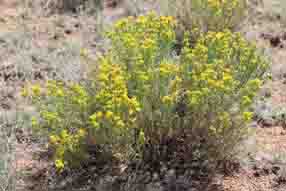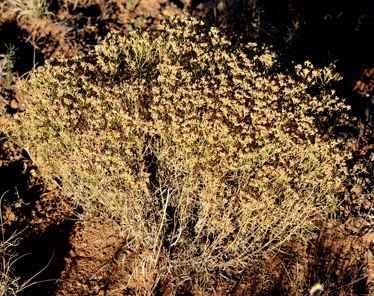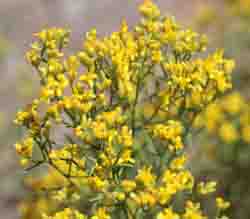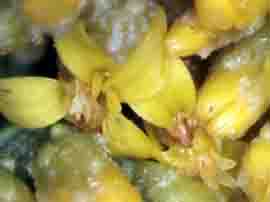 |
 |
Plant w/flowers |
Plant w/seeds |
The Flowers
 |
 |
Flowers 50X |
Description
"Gutierrezia sarothrae is a perennial subshrub that ranges from 20 to 100 centimetres (7.9 to 39.4 in) in height. The stems are green to brown, bushy, and herbaceous, and branch upwards from a woody base.[3] The stems die back during dormancy, giving the plant its broom-like appearance.[3] They range from smooth to having some short hairs, and may be resinous and therefore sticky when touched.[4]Dense clusters of small, yellow ray flowers form in clusters at the end of the stems from mid-July to September.[3][5] As the stems are about the same length, this causes the plant to often appear domed or fan-shaped when flowering.[5] The leaves are alternate and linear, and 5 to 60 millimetres (0.20 to 2.36 in) long and 1 to 3 millimetres (0.039 to 0.118 in) wide.[4] The lower leaves are usually shed before the plant flowers.[5] During its first year of growth, G. sarothrae produces a long, woody taproot, and numerous lateral roots as the plant matures.[6]" (Wikipedia)
Ethnobotanical Uses
Medicine:
"Gutierrezia sarothrae was used by the Native Americans of the Great Plains for various reasons.[3][4][5] The Comanche bound the stems together to make brooms. The Blackfoot used the roots in an herbal steam as a treatment for respiratory ailments. A decoction of the plant was used by the Lakota to treat colds, coughs, and dizziness, while a concentrate made from the flowers was used by the Dakota as a laxative for horses. The Navajo rubbed the ashes of G. sarothrae on their bodies to treat headaches and dizziness, and also applied the chewed plant to wounds, snakebites, and areas swollen by insect bites and stings. The Zuni used an infusion of the blossoms as a diuretic and to "make one strong in the limbs and muscles",[9] and an infusion of the whole plant was used topically for muscle aches.[10]" (Wikipedia)
Internet Resources